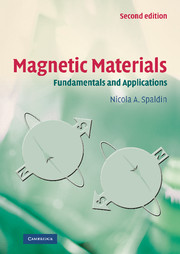Book contents
- Frontmatter
- Contents
- Acknowledgments
- I Basics
- 1 Review of basic magnetostatics
- 2 Magnetization and magnetic materials
- 3 Atomic origins of magnetism
- 4 Diamagnetism
- 5 Paramagnetism
- 6 Interactions in ferromagnetic materials
- 7 Ferromagnetic domains
- 8 Antiferromagnetism
- 9 Ferrimagnetism
- 10 Summary of basics
- II Magnetic phenomena
- III Device applications and novel materials
- Epilogue
- Solutions to selected exercises
- References
- Index
9 - Ferrimagnetism
from I - Basics
Published online by Cambridge University Press: 05 June 2012
- Frontmatter
- Contents
- Acknowledgments
- I Basics
- 1 Review of basic magnetostatics
- 2 Magnetization and magnetic materials
- 3 Atomic origins of magnetism
- 4 Diamagnetism
- 5 Paramagnetism
- 6 Interactions in ferromagnetic materials
- 7 Ferromagnetic domains
- 8 Antiferromagnetism
- 9 Ferrimagnetism
- 10 Summary of basics
- II Magnetic phenomena
- III Device applications and novel materials
- Epilogue
- Solutions to selected exercises
- References
- Index
Summary
To interpret the magnetic properties, I assumed that the predominant magnetic interactions were exerted between the ions placed at sites A and ions placed at sites B, and that they were essentially negative.
Louis Néel, Magnetism and the Local Molecular Field, Nobel lecture, December 1970Finally we have reached the last chapter in our survey of the most important types of magnetic ordering. In this chapter we will discuss ferrimagnets. Ferrimagnets behave similarly to ferromagnets, in that they exhibit a spontaneous magnetization below some critical temperature, Tc, even in the absence of an applied field. However, as we see in Fig. 9.1, the form of a typical ferrimagnetic magnetization curve is distinctly different from the ferromagnetic curve.
In fact ferrimagnets are also related to antiferromagnets, in that the exchange coupling between adjacent magnetic ions leads to antiparallel alignment of the localized moments. The overall magnetization occurs because the magnetization of one sublattice is greater than that of the oppositely oriented sublattice. A schematic of the ordering of magnetic moments in a ferrimagnet is shown in Fig. 9.2. We will see in the next section that the observed susceptibility and magnetization of ferrimagnets can be reproduced using the Weiss molecular field theory. In fact the localized-moment model applies rather well to ferrimagnetic materials, since most are ionic solids with largely localized electrons.
The fact that ferrimagnets are ionic solids means that they are electrically insulating, whereas most ferromagnets are metals.
- Type
- Chapter
- Information
- Magnetic MaterialsFundamentals and Applications, pp. 113 - 129Publisher: Cambridge University PressPrint publication year: 2010
- 1
- Cited by

